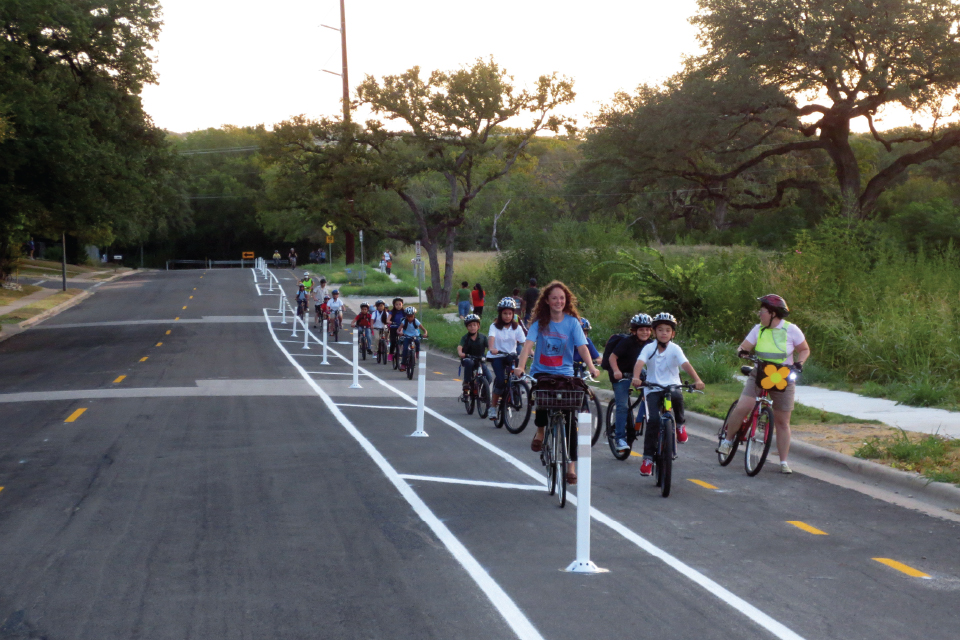Getting Kids to Bike and Walk to School

Over the past five decades, the number of children walking and biking to school has plummeted—from 48 percent in 1969 to 13 percent in 2009 among children ages 5 to 14. Meanwhile, childhood obesity rates have skyrocketed. In Austin ISD schools, 35 percent of children in grades 3 to 12 are overweight or obese. Fortunately, several innovative things are happening around Austin to reverse these trends and get kids back on their bikes and feet.
Bike/Walk-to-School Innovations in Austin
In August, the City of Austin launched a major pilot initiative to encourage children to walk and cycle to Hart Elementary School, which serves a high proportion of low-income students with limited opportunities for activity. After installing a 1.3-mile bicycle track connecting nearby apartment complexes to the school, the City secured 300 bikes to donate to children who commit to cycling to school.
The City also set up bike trains and walking school buses with adult monitors to pick students up from their apartment complexes and supervise their commute to school. When the students arrive on campus, they swipe a special card so their parents can know they arrived safely.
A bike train is an organized group of students who cycle together along a pre-arranged route to school under the close supervision of adults; a walking school bus is the pedestrian version of a bike train. In Portland, Oregon, bike trains have become a predominant feature of kids’ commute to school, supported by a robust cycling culture and even a website with information on bike trains in operation around the city. In Seattle, the school district is working to set up a bike train or walking school bus at every elementary school in the district, with a goal of getting 50 percent of kids walking and biking to school.
In addition to the Hart Elementary program, at least five other elementary schools in Austin’s low-income neighborhoods have started walking school bus programs. There are also a number of parent-run bike trains in the city, such as the one implemented at Brentwood Elementary.
Benefits of Walking and Cycling to School
In addition to instilling life-long healthy habits, getting kids to school by bike and foot offers a number of other benefits. It reduces morning and afternoon traffic congestion. In some communities, as much as 30 percent of morning vehicle traffic is from children being driven to school. Kids who utilize active transportation to school also perform better academically, according to a recent Danish study. Some of my family’s favorite things about our morning walks to school have been bonding with neighbors and spending that extra quality time together.
Opportunities for Creating a More Robust Bike/Walk To School Culture
While Austin has made great progress recently in encouraging kids to walk and bike to school, more needs to be done to increase the volume of kids who opt for this daily exercise.
One of the biggest barriers to participation is safety. We should all be advocating for more local funding to create safer routes to schools, including sidewalks and cycle tracks. Portland and Seattle are both building networks of neighborhood greenways that give priority to cyclists and pedestrians. By 2015, 80 percent of Portland’s residents will live within a half-mile of a neighborhood greenway.
There are also lots of opportunities for encouraging students to bike and walk to school at a neighborhood and school level. In addition to bike train and walking school bus programs, kids respond well to class contests and rewards. Schools can sign up for the City’s BOW WOW (Bike on Wednesday—Walk on Wednesday) program, which offers prizes to kids who regularly bike and walk to school. Doss Elementary and Martin Middle School have adopted a high-tech approach by implementing Boltage, which uses a solar-powered reader that records each child’s bike trip to school. Those records are collected and then used to reward students who bike regularly to school.
5 Easy Steps for Starting Your Own Successful
Bike Train and Walking School Bus
1. Start by inviting a core group of families who live nearby to gather at one location.
2. Identify the route to be taken to school and meeting spots along the way.
3. Create a regular schedule, whether it’s daily, weekly, or monthly.
4. Designate which adults can commit to supervising the children on the route. The Centers for Disease Control and Prevention recommends one adult for every six children. Have at least one adult in the front leading the group and one bringing up the rear.
5. Advertise to other families in the neighborhood. Be creative—use word-of-mouth, social media, or the school’s resources.






